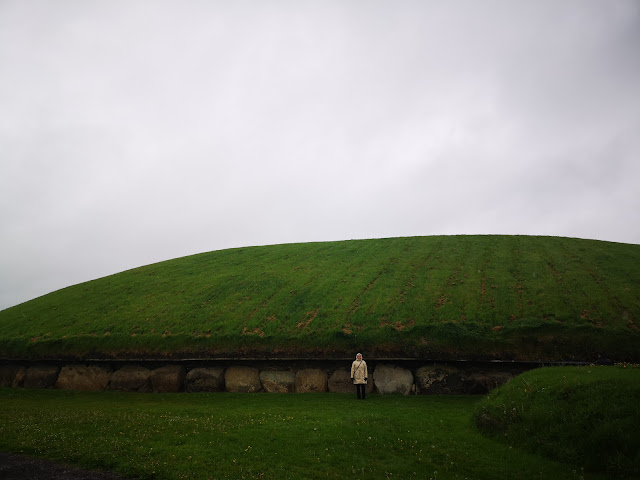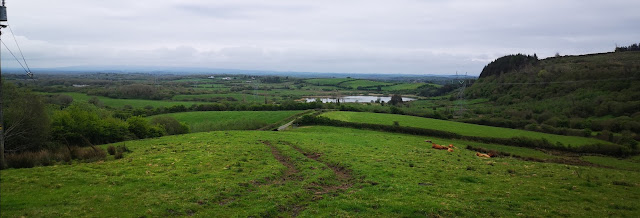
Our last few days in Dublin were going to be full so it was a relief to see the sun shining when we woke to begin exploring this old city on the Liffey river. We caught the bus into the center of town, walked past the Dublin castle and down into St Stephen's Green, a nine hectare green space in the middle of Dublin where we found the Memorial Sculpture of James Joyce, one of the most influential and important Irish writers of the 20th century. The downtown was crowded and, being Saturday, full of tourists, so it was nice to stroll among the leafy paths of the park for a while. From there we walked over to Trinity College's Library to see the famous Book of Kells, an illuminated manuscript created by Early Christian monks around 800AD - one of the great treasures of medieval Europe that you may not have even heard of. It contains the four gospels together with various texts and tables and is a masterwork of Western calligraphy, considered by many as Ireland's finest national treasure. You only get to see one page that is opened as it is protected and sealed within an airtight display case so nobody can touch it. From there we walked into the next part of the Old Library called the Long Room filled with over 200,000 of the Library's oldest books. Breathtaking if you like old books and even if you don't the beautiful barrel-vaulted ceiling is a joy to behold. Lining the central walkway are marble busts of famous philosophers and writers, the first commissioned in 1743, and the 15th century 'Brian Boru' harp, the national symbol of Ireland.
 |
| Book of Kells, Trinity College, Dublin |
 |
| Brian Boru harp, Long Room |
It was Saturday in the Capital so we first decided to go check out The Temple Bar area, a busy riverside neighborhood spread over some old and uneven cobbled lanes that you can easily get lost in, These crowded pubs are the center of Dublin's nightlife and it was nuts when we there although it was only early afternoon, impossible to move and everyone singing, drinking and high fiving. We didn't stay long, just enough time to take some photos then opting to walk to the National Museum instead, a treasure house of anything Irish and with a very impressive display of Viking artifacts found locally. A walk along the Ha'penny bridge (built in 1816 and officially called the Liffey Bridge, it was used as a toll bridge for 100 years and you were charged, you guessed it, a half penny) and time to call it another day. Tomorrow was the Cathedral and a bus ride out to the the Royal Hibernian Military School where my Grandfather William Steward and his brother Great Uncle Harry Edward were sent as a young boys.



 |
| Temple Bar, Dublin |
 |
| Viking swords and axes, National Museum of Ireland |
 |
| Time for a Guiness, The Bull& Castle, Dublin |
 |
| Ha'penny Bridge, Dublin |
The bus ride out to the west end of the city took forever but we arrived mid-morning at beautiful Phoenix Park and St Mary's Hospital where the military school buildings remain but now part of the hospital. The building has been repainted and looks exactly as it did when it was constructed in 1771. The institution originally went by the name Hibernian Society for the Orphans and Children of Soldiers (until 1846). By the mid 19th century the school acted as a feeder to the British Army when children as young as 12 could enlist, By1922 it had moved to Folkestone. We wandered about the grounds and found the old chapel and another church where possibly my Grandfather attended. In the graveyard we discovered a sad part of the history of the school - the gravestones of dozens of young boys aged eight through thirteen. No records remain of the time he was there but we did get a feeling of how it must have been to be a boy there under the stern gaze of the instructors. What they endured can only be imagined.





 |
| Chapel, former Royal Hibernian Military School, Dublin |
We took another bus back to center town to see Saint Patrick's Cathedral, the National Cathedral of the Church of Ireland, and home to many depictions of Ireland's most famous saint. Nobody knows exactly what he looked like so all the paintings and statues looked different. We spent an hour inside this, our last Cathedral to visit on this trip, and had a chance to see a display case featuring the death mask, one of his sermons and a cast of the skull of the writer Jonathan Swift. He is best known for Gulliver's Travels but it was interesting to learn he was also Dean of the Cathedral from 1713 to 1745. His pulpit is on display as well and I had the chance to feel its well worn surface. He is buried under the floor alongside his best friend Stella. After our visit we walked along the River Liffey to O'Connell Street to gaze up at the Spire of Dublin, a 390 foot stainless steel pin-like monument. It was erected in 2003 on the same spot where Nelson's Pillar stood until it was destroyed by an IRA bomb in 1966. Some opposition initially greeted the Spire and it has inspired a number of nicknames, as is common with any public art in Dublin - the nail in the Pale, the stiletto in the ghetto, the erection at the intersection and my favorite, the Stiffy by the Liffy. A nice meal and a toast to Ireland ended our day. Tomorrow we fly home after 48 days; over 4000 miles by car alone, 125 miles walking and memories too numerous to count. GWS




 |
| Saint Patrick's Cathedral, Dublin |
 |
| Spire of Dublin, O'Connell St |
 |
| slan atha cliath (goodbye Dublin!) |
 |
| goodbye to the green field of Ireland |
 |
| hello to the white landscape of Canada |













.jpg)


































.jpg)









